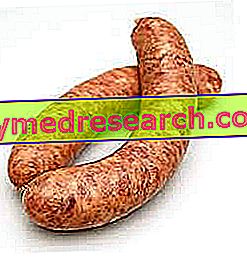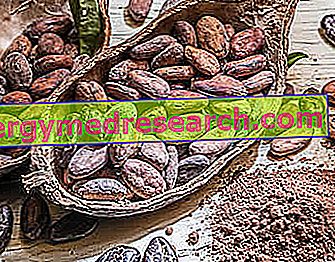Generality
Sausage is a preserved and preserved meat obtained mainly from pork / wild boar (especially Sus scrofa ). Its discovery is attributable to the Lucanian populations (before the birth of Christ); not by chance, the archaic nomenclature of the sausage corresponds to the noun of " lucanica".

Sausage is a food based on chopped meat, added with cooking salt (NaCl) and coated with a natural or synthetic gut (animal intestine or cellulose film), which protects it from oxidation and biological contamination. Currently, the sausage and all its regional variations are grouped in the list of traditional Italian food products .
The sausage comes from the need to:
- Discard the non-edible portion of the animal, preserving the edible portion as best as possible
- Facilitate food transport
- Portion the edible part in rocchi without compromising its integrity
- Increase meat shelf life.
In order to further extend its shelf life and, IN ORIGIN, to hide the meat's rancidity, sausage tanning (commonly known as "impasto") is always integrated with spices, aromas and other ingredients (with antibiotic and vermifuge action); Among the most common we mention: red wine, pepper, chilli pepper, fennel seeds, coriander, nutmeg, garlic, honey etc.
The kind readers will ask themselves how it can be possible that, even in the sausage (which is a food that can be preserved with respect to fresh meat), the fat portion may become rancid; the answer is quite simple. In the historical period in which the sausage processing procedure was conceived, the man was NOT in possession of any cold preservation technique (today also basic at domestic level); therefore, the foodstuffs (including sausage) were stored at temperatures unsuitable for long conservation, with consequent rancidity and risk of putrefaction.
Today, the sausage has innumerable variations, or as many as there are production areas, local traditions and family recipes. The most important variables are:
- The quality of meat and fat for sausage tanning: although it represents mainly (and originally) a preserved product based on pork or wild boar, there are other variations with white meat (chicken or turkey or goose sausage), red meat ( horse sausage) and black meat (venison sausage). NB . While modifying the derivation of the meat, the fat used for the sausage should always be that of pork (as it is more conservable than the others)
- The presence or absence of offal in sausage tanning: in addition to the types of muscle and fat used, there is also the possibility of supplementing the sausage with some offal; in particular, liver sausage and lung sausage are well known
- The type of chopping of meat for sausage tanning: the "cubication" with a knife and that by means of the mincer are distinguished
- The size of the sausage: the diameter varies depending on the type of product to be obtained. The sausage can be narrow and long or short and large; with regard to the latter, it is then necessary to apply a ligature with string that allows to portion the stuffed gut
- The choice of aromas for sausage: garlic sausage, pepper sausage, chilli sausage, fennel sausage or fennel seeds, coriander sausage etc.
- The duration of the preservation of the sausage: adjustable especially by means of the QUANTITY of added salt; the sausage can be used for "short-term" consumption (with a little salt and a drying time of just 20-30 days) or "long-term" (with more salt, drier, almost always large and seasoned similar to a salami)
- The presence or absence of food additives in the sausage: while home production refrains from the use of food additives, industrial ones must guarantee a quality standard (high or low) and a certain shelf life. Therefore, ascorbic acid and sodium or potassium nitrates / nitrites are used for antioxidant purposes; while to guarantee its softness and preservability the powdered milk is added
- Further forms of preservation of the sausage: if it is not intended for long storage by seasoning, the sausage can be subjected to other forms of conservative expansion; in particular, oil-in-the-oil (sausage in oil), preservation in lard / lard and smoking (smoked sausage) are widespread.
The sausage is therefore one of the typical products obtained from the slaughter of the pig; the sizes used for the tanning of the sausage are almost superimposable to those of the salami, from which it is distinguished mainly on the doses of the other ingredients or for the processing. However, as can be learned by reading carefully the dedicated article (pork), there is no "rule" that requires the use of one or the other anatomical portion (understood as muscle or fat) even if, " by logic ", from the dismantling of a HEAVY pig (see the article Maiale) each size lends itself to one type of processing rather than another. All foods based on chopped meat and to be preserved more or less long (such as sausages) require: the muscle cuttings (of the thigh, capocollo or more rarely of the loin), the body districts that need a deep and probing trimming (like the shoulder) and the portions of highly conservable and medium-quality fat (so not the throat but not even the adrenal; pancetta and some portions of lard represent a good compromise).
Hygienic aspects
The sausage is a conservative form of fresh meat; however, this does not mean that it is totally immune to microbiological contamination or parasitic infestations. Even with regret, it is necessary to specify that (in the restaurant sector or wanting to ensure the maximum level of hygienic-food safety within the walls of the house) between a "home" food and an industrial-derived one, only the latter can be defined as "guaranteed" and based on the application of a production specification endorsed by the competent authorities. As for the organoleptic and gustatory difference between the two types of sausage, well, there is no doubt! A product made with care and family tradition is certainly superior to the widespread alter-ego on large retailers; however, carefully analyzing the risks arising from the intake of a contaminated sausage, I believe there will be no major delay in choosing the safest supply source.
First of all, the sausages have a different risk index between the various types of processing and methods of consumption; all those COTTE do not include any risk of PARASITOSIS, as these organisms (even if present) die with heat treatment. On the contrary, the CRUDA sausage (both dry and fresh) has a high risk of contamination with Toxoplasma gondii and is a food potentially responsible for toxoplasmosis . This parasite - which in humans is only initially manifested and (in a latent form) persists indefinitely in the host - can be the cause of serious complications in immuno-depressed subjects or in the fetus (eg severe malformations and / or miscarriage). The same applies to Trichinella spiralis, responsible for Trichinellosis ; this parasite is capable of severely damaging any organism and not just the immunosuppressed or fetus. Also the Tenia solium, the Echinococcus and the Opistorchis felineus are part of the parasites that can be detected in the raw sausage and are potentially responsible for infestations in the human being.
As far as bacteria and related food-borne diseases are concerned, in the sausage it is not uncommon to develop various Salmonella strains (which may originate salmonellosis ) present in the intestine from the infected animal and transferred to the meat by means of inadequate slaughtering; Salmonella can be inoculated into the sausage also by contamination by the operator himself. Fortunately, the salmonellae are thermolabile and do not produce toxins resistant to heat, therefore they are dangerous only when taken through a CRUDE sausage, while they are destroyed by cooking.
Much more serious but fortunately easier to identify (due to the rancid odor or the possible swelling of sausage jars in oil) is the Clostridium botulinum contamination, which causes Botulism . This bacterium, by means of its neurotoxins, can paralyze the respiratory and cardiac muscles until death; it affects both the fresh sausage, and the one that can be preserved the most (dry, in oil, smoked) but still CRUDA. Fortunately, botulism is effectively prevented by cooking sausage.
A good compromise between guarantee of healthiness and taste of sausage is the supply to small producers in order, or butchers who have the specific license to produce sausages.
Nutritional characteristics
Sausage falls into the category of "foods unsuitable for the diet of modern man". It is a product poor in water, rich in lipids (saturated fatty acids and cholesterol, especially in liver sausage), high calorie and excessively salty; just think that 100g of fresh sausage brings a quantity of sodium equal to twice the minimum required to maintain health, and up to 60% of the maximum recommended cholesterol level.
NB . There are no specific data concerning the ratio of fatty acids but, analyzing the composition of the various sizes used in the production of sausage, it is absolutely possible that the saturated ones predominate.
As many will know, dietary cholesterol and saturated fatty acids are responsible (synergistically with being overweight) for a metabolic alteration of lipoproteins that raises the risk of atherosclerosis; not surprisingly, in the diet against hypercholesterolemia, sausages are a "taboo" food.
The reduced concentration of water and the high intake of fats and proteins give the sausage a very high caloric value. This is a decidedly negative feature as, based on the energy expenditure attributable to the average adult population (about 2000kcal), a SCARSA or MEDIUM portion of fresh raw sausage (150-200g) provides 450-600kcal, or 20-30 % of daily energy. The excess of sausages in the diet (in the absence of physical and desirable physical activity) is therefore correlated to the increase in fat mass and body weight.
Even the high sodium content in the sausage significantly limits its use; this mineral, already present in excess in the western diet, is probably responsible (once again synergistically for being overweight and sedentary) for the increase in blood pressure (hypertension) and for the consequent increase in cardiovascular risk.
Fortunately, the sausage is NOT an "empty" food; it also contains appreciable nutrients, such as proteins. high biological value, iron (especially in liver sausage), thiamine (vit. B1) and niacin (vit. PP). In the liver sausage there are also appreciable quantities of retinol (vit. A), riboflavin (vit. B2) and vit. C (ascorbic acid - even if destroyed by cooking).
In the industrial sausage, which also contains milk powder, there are traces of carbohydrates consisting of lactose, while in liver sausage small amounts of glycogen appear (hepatic reserve sugar).
Homemade light chicken sausages
Light Chicken Sausages - Homemade
X Problems with video playback? Reload from YouTube Go to Video Page Go to Video Recipes Section Watch the video on youtubeVegan sausages
Whether dictated by ethical, religious or health reasons, the choice to follow a vegan diet requires the removal from the diet of all foods of animal origin, including sausages. Our personal cooker, Alice, has therefore thought of preparing a vegetable substitute that can satisfy even the most reluctant palates to give up meat flavors.
Soy Sausages
X Problems with video playback? Reload from YouTube Go to Video Page Go to Video Recipes Section Watch the video on youtubeNutritional values
Nutritional composition of Sausage - Reference values of the INRAN Food Composition Tables
|
| ||||||||||||||||||||||||||||||||||||||||||||||||||||||||||||||||||||||||||||||||||||||||||||||||||||||||||||||||||||||||||||||||||||||||||||||||||||||
|
| ||||||||||||||||||||||||||||||||||||||||||||||||||||||||||||||||||||||||||||||||||||||||||||||||||||||||||||||||||||||||||||||||||||||||||||||||||||||







